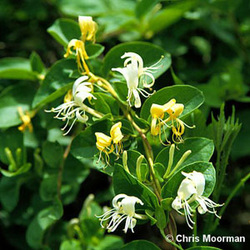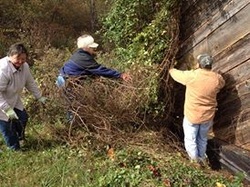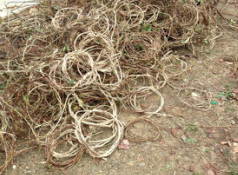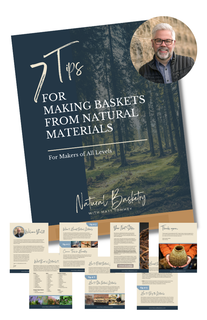 Japanese Honeysuckle in Bloom Japanese Honeysuckle in Bloom I came to honeysuckle vine later in my basketry career. Since I always had such a love for and understanding of kudzu, rarely did I ever look for other natural materials to use. However, when I found honeysuckle vines, that changed. In my book it can never replace kudzu, but it sure is a wonderful material to weave with. The trick with honeysuckle, as will all natural materials, is understanding what it will and won't do, it's strengths and weaknesses. There are those folks out there that use honeysuckle almost exclusively for their weaver. The Cherokee's still use a lot of native and Japanese honeysuckle in their work in random weave, twining, twill and rib basketry. Most of what I've used it for over the years tends to be as an additional sculptural element. The reason why is that the make up of the vine lends itself to being celebrated as a special feature, not just a normal weaver.  Harvesting Honeysuckle Vines Harvesting Honeysuckle Vines As a young vine, the honeysuckle vine runners can be very, very long - 20ft or more - and very pliable. The vine has a fine, paper-like bark on it that is a caramel brown color once it's matured a bit. When very young, it will be green. As the vine matures over years, it usually becomes crooked, very woody and has a lot of twists and turns. Usually you'll find honeysuckle growing in wet, bottom areas like around creeks, marshes or rivers. You can also find honeysuckle growing on barns, buildings or in gardens. There are lots of different varieties that can be cultivated for home enjoyment within your own basketry garden. "Identification: Japanese Honeysuckle is an evergreen woody vine that may reach 80 feet in length. The leaves are opposite and elliptically shaped. The tan vine may reach a thickness of 2 inches in diameter. Fragrant, white or pale yellow tubular flowers appear in April to August. Spherical, black glossy berries containing 2 to 3 seeds mature from June to March. Ecology: Japanese Honeysuckle is a common invasive plant in the Southeast. The shade tolerant vine occurs along field edges, right-of-ways, under dense canopies, and high in canopies. This invasive vine colonizes by prolific vine growth and seeds that are spread by birds" from http://www.ncsu.edu  Honeysuckle Vine Coils After Harvesting Honeysuckle Vine Coils After Harvesting Like all vines, I recommend harvesting honeysuckle vine in the fall and winter months. That way they are less likely to snap when pulling them. You can always remember when pulling vines "Sappy Snappy". That basically means that when the sap is high, in the spring and summer months, vines are more likely to break when being harvested. Also, winter is a lot easier to harvest vines because there are very few bugs, no critters are out and all the leaves are gone. Once you get your vines, you can store them in a cool, dry place until you're ready to use them. Just like the image here from one of my recent basket weaving classes, I recommend that you coil the vines into loose coils. However, be sure that they are small enough to fit in whatever pot you're going to use to boil them when you're ready to weave. Which brings me to the next step.  Honeysuckle Vine, Kudzu and Bark Honeysuckle Vine, Kudzu and Bark Whenever you're using honeysuckle vine, you'll want to boil it for 3 reasons, pliability, bugs and bark. Obviously, boiling makes the vines much more pliable and easy to use when weaving. Also, any bugs that are on the vines or in them for that matter will be nixed when you boil the vines. Lastly, boiling the vines will loosen up the bark so you can remove it from the vines. You'll want to boil honeysuckle vines for about 20-30 minutes or so - until they are rubbery flexible. (NOTE: Honeysuckle has a real papery outer bark that comes off pretty easily. It also has another layer of bark that's usually pretty tightly attached to the vine. Get that completely off too. It can be a pain, but once you get a clean vine, it will turn a beautiful ivory white.) With small vines, you can literally put on some 'gripper gloves' (you know the garden gloves with gripper on the palms and fingers), pinch the vine and pull the bark right off. With larger vines, I recommend you go all the way down the vine twisting the wet bark on the vine. Then once it's totally loosened up peel it off. If you're a papermaker, this bark is fabulous for natural fiber paper making. You can also use the long strands of honeysuckle bark for twining or making cordage. Now that you have your honeysuckle all boiled and cleaned you'll probably be ready for a nap! Welcome to weaving with natural materials :) However, now the fun begins. I usually separate my prepared materials by size. Large, gnarly pieces are great for handles, long straight pieces for weaving and then medium crooked pieces for weaving or as an architectural element on other baskets. Whatever it is, you'll want to weave while the vines are wet and pliable. Hope this article helps you feel confident in going out and harvesting your own honeysuckle vines!
11 Comments
Denise Luddeke
7/5/2014 01:13:24 pm
This article was very helpful!! We have honeysuckle growing on our property and mom and I have recently learned Cherokee basket weaving...we want to try the baskets in honeysuckle. Thanks for the tips!
Reply
Julie
12/22/2016 08:12:04 pm
Love this! I'm so eager to begin harvesting indigenous vines and learning to weave baskets. We are preparing to start a therapeutic farm to help women heal, and I'm excited to include gathering vines and weaving naturalistic baskets as one of our therapy programs. Thanks, your articles and pics are great!
Reply
5/17/2017 07:55:07 am
Your article inspires me to plant Japanese Honeysuckle in my basketry garden. Ahhhh...The willow weavers have my heart, but willows don't grow in the desert where I live in Phoenix Arizona. Actually, it was having to rake up such an abundance of Jacaranda sticks every season that got me started down the basket making road. It seems such a waste to throw them away. These 10-15 inch long sticks 1/4" in diameter that taper to a point are brittle but not as delicate as pine needles. If they can make baskets with pine needles, then why not Jacaranda sticks? That's when I found your Youtube video about harvesting natural materials which gave me the words "learning to speak the language of natural materials." I love learning what to do with the things I have on hand right now. I supposed that's what basket weavers have always done. As a metalsmith, I have lots of copper wire. So my first basket was a round blackberry bramble basket inspired pattern using all wire. I wish I could attach a photo for you. Basket #2 still in the works is using the Jacaranda sticks and copper wire in the place of raffia or sinew using pine needle basket techniques to coil the bundles of soaked sticks. Basket #3 is a giant garden trellis inspired by the living willow hedges. I wanted to form a giant basket archway from branches. I lashed two 12-foot Jacaranda branches at their narrow ends to form 16-foot lengths to bend into an archway. I made 7 of those 16-foot long pieces. Laying them side by side I then wove thinner cross members in and out while the branches were green. I learned that the wood is brittle and snaps with manipulation if too thick or allowed to dry. A simple lashing the cross members is more what I will do next time. It's all about learning what the materials will do at different stages. A little jute rope and some rudimentary macrame' skills came in very handy let me tell you. Though my failed basket archway ended up being a 16-foot long by 5-foot ladder/sculpture/trellis thingy leaning against the brick wall, I'm still totally enchanted with the woven texture in the landscape. It's a process of discovery. To use all the little branch trimmings, I learned that there is a lovely white wood under the bark which is easily scraped off with a knife. Collecting the materials seems to be meditative and grounding for me. There's an attractive bucket of those stripped branches on my back porch where I'm starting to amass collections of natural materials. I'm getting away with keeping them outside since it's so dry here. I sit in the shade of my back porch where I'm inspired to experiment with the qualities of each. So, I'm totally hooked now. Last week we planted some Hesperaloe Parviflora (Yellow Yucca) and a stand of Dietes Bicolor (African Lily). Now I'm on the hunt for Japanese Honeysuckle to add to my basketry garden. Basketry is so fastinating, especially using naturals. What I love the most is the connection with both the materials and the people I've been meeting. I'm so glad I found you, Matt Tommey. Your articles are so inspiring and at some point, I hope I get the opportunity to meet you perhaps in a class. Now, if I can just find a good book. Do you recommend any books in particular for the newly initiated? Tippy Mueller from Phoenix, Arizona, USA
Reply
I recently found you through You-Tube. What great information! I am completely new to basket weaving but really interested in doing it and wanted to learn what natural materials I can use instead of going to buy materials. We have plenty of honeysuckle! I'll be harvesting it this winter.
Reply
10/13/2017 03:45:36 pm
I was at brunch with some friends and we were all talking about a beautiful African basket that my friend is ordering. It made me curious as to the different styles of weaving that there were, like honeysuckle. No one would have guessed that you boil the vines before using them.
Reply
Marcia
1/26/2018 05:42:15 am
We have honeysuckle here in Missouri, but it is more the form of a bush. Is this useful at all?
Reply
Barbara
10/4/2021 05:10:12 am
Hello. Thanks for your article. I'm just starting basket weaving though I've always loved baskets. I'm still in the learning stage, watching videos, reading books and, now, collecting vines. I live in Japan and am excited to have found honeysuckle all around me now that I know what to look for. It's called "suikazura" here. Thanks for validating my newfound love for this vine!
Reply
Theresa Martin
12/7/2022 07:17:54 pm
It's funny that this is your article without attributing it to you: http://allbasketweaving.weebly.com/blog/how-to-weave-a-basket-with-honeysuckle-vines
Reply
Jennifer M Cameron
11/23/2023 12:27:05 pm
You were very helpful and I enjoyed your witty! Thank you very much!
Reply
Tony
5/27/2024 08:26:17 am
Hi folks,
Reply
Leave a Reply. |
AuthorMatt Tommey is a leader in the contemporary basketry movement and has been a maker for over 25 years. The focus of his work centers around the use of southern invasive plant species in basketry. He has served on the board of directors for the National Basketry Organization and taught at Arrowmont, the John C. Campbell Folk School and other locations both in the US and internationally. |
Mailing Address: PO Box 1382 Lindale, Texas 75771
Studio Address:Private By Appointment Only
(404) 538-5173.


 RSS Feed
RSS Feed